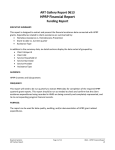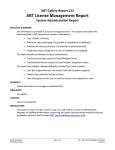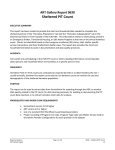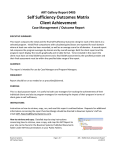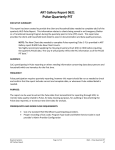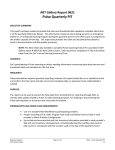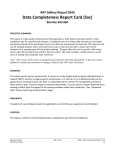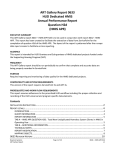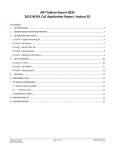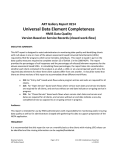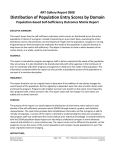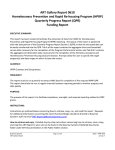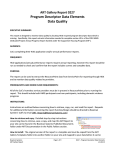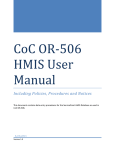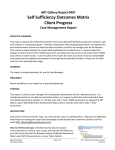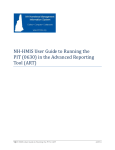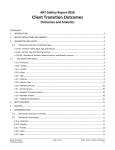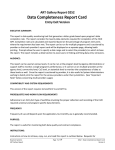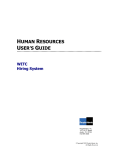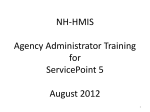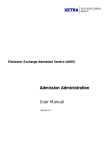Download User Manual - nh
Transcript
ART Gallery Report 0609 Pulse New Clients EXECUTIVE SUMMARY: This report has been created to provide the client and household data needed to complete tabs D,E,F and G of the quarterly HUD Pulse Report. This information relates to clients being served in an Emergency Shelter or a Transitional Housing Program for the first time during the reporting quarter. In addition to providing the data needed for Pulse reporting, this report also provides the client and household level detail to assist in documentation and data quality processes. The Pulse definition of NEW client upon which this report is based is as follows: New clients are those who: a) have not received any homeless services during the past 15 month period (the period is the 15 continuous months prior to the initial entry date); and b) began receiving homeless residential services for the first time during the past quarter (the quarter being reported). HUD guidance for Pulse household reporting is as follows: The Household Definitions should be based on Revised Data Standards. The household should be categorized based on its composition on the day of entry during this quarter. A household is only counted based on its first entry. If there are changes in the composition of a household after its initial entry, the household categorization should not be altered. NOTE: The Quarterly Point in Time data needed for Pulse reporting (Tabs B‐C) is provided in ART Gallery report # 621 Pulse Quarterly PIT Data. Data require for completion of Tab A should be taken from the CoC’s annual Housing Inventory Chart AUDIENCE: CoCs participating in Pulse reporting or others needing information concerning data about persons and household which are homeless for the first time. FREQUENCY: Pulse participation requires quarterly reporting, however this report should be run as needed to check and confirm that the report includes correct and complete data, or whenever Pulse related detail is needed. PURPOSE: The report can be used to extract the Pulse data from ServicePoint for reporting through HDX, to monitor data quality related to Pulse, for data cleaning purposes, for auditing or documenting the Pulse data reported, or to extract new client data for analysis. Bowman Systems ART Gallery Report Page 1 of 19 0609 – Pulse New Clients version 5 PREREQUISITES AND WORK FLOW REQUIREMENTS • Use of a closed service, HUD compatible workflow by participating providers for a period of at least 15 months prior to the reporting period. • Proper recording of CoC code, Program Type Code and Shelter Service Code in each provider’s Admin Provider Configuration INSTRUCTIONS: Instructions are outlined below concerning how to retrieve, copy, run, and read this report. Requests for additional information concerning the report function/design should be directed to Bowman Systems’ staff via email ([email protected]). How to retrieve and copy: Detailed step‐by‐step instructions concerning how to retrieve, save a copy, and map this ART Report to your site can be found in the Bowman Systems Published Documents folder under ART Documentations in the Public Folders section. How to install: The original version of the report is a template and must be copied from the ART Gallery Templates folder into another folder on your site and mapped to your data before it can be used. Detailed instructions for installing report templates are provided in the Bowman Documentation folder on your ART site. Before running the report: Prior to running the report the user must determined the provider or providers to be included in the report and a date ranges on which to base the results. How to run: Upon opening the report, the user will be prompted (see Diagram 1) to specify parameters which control the data returned by the report. Once the user has provided these parameters by responding to the user prompts, a green check‐mark will appear next to each field to indicate that a selection has been made. The user should then single‐click the “Run Query” button to generate the report. Diagram 1 Bowman Systems ART Gallery Report Page 2 of 19 0609 – Pulse New Clients version 5 The four user prompts contained in this report are: 1. Enter Start Date for the Quarter: The user should type in, or select from the calendar, the first day of the quarter for which the report is being prepared. 2. Enter End Date for the Quarter PLUS ONE DAY: The user should type in, or select from the calendar, the day immediately following the last day of the quarter for which the report is being prepared. For example, if the reporting quarter is October 1 2009 ‐ December 31 2009, then January 1, 2010 should be entered/selected. 3. Select CoC Code: Click the “refresh list” icon and wait for the left window to refresh. Now select the desired CoC on which to base the report by highlighting it in the left window and moving it into the right window using the right selection arrow. 4. Select Provider(s): Click the “refresh list” icon and wait for the left window to refresh. Now select the provider or providers to include, by highlighting them in the left window and moving them into the right window using the right selection arrow. Important NOTE: All selected providers must be either an Emergency Shelter Program or a Transitional Housing Program as indicated by their Program Type Code. Selected Providers with a missing or different Program Type Code will NOT be included in the report results. All selected providers must also have the specified CoC Code. Selected Providers with a missing or conflicting CoC Code will NOT be included in the report results. How to read: This report contains eight data tabs. Each tab is a sub‐report containing three sections: • Report Header: The header contains the title of the report and the tab/subreport. When running the report in “modify” view, the report header is only visible in print/page layout mode. • Report Footer: The report footer contains the title of the report, the name of the tab/sub‐ report, the page number, the version number, and the date/time the report was run /printed. Like the header, the footer is only visible in print mode when the report is run in modify view. • Report Body: The report body is the main section of the report located between the header and the footer where the reports data is displayed in a variety of different chart formats. The data contained in each of the tabs in this report is displayed and described below: Bowman Systems ART Gallery Report Page 3 of 19 0609 – Pulse New Clients version 5 Diagram 2 Tab A – Provider Summary (Diagram 2): This tab contains unduplicated counts of NEW Pulse clients by provider. A total counts and breakdown by program type is also included. As noted above, all providers must be either an Emergency Shelter Program or a Transitional Housing Program as indicated by their Program Type Code and must have the specified CoC Code. If a provider has been selected that does NOT meet these conditions, the provider will be shown in the listing but column 4 will display “N/A” in red font to indicate that their data has been excluded from the report and their missing of conflicting provider designations will also be highlighted in red font. Bowman Systems ART Gallery Report Page 4 of 19 0609 – Pulse New Clients version 5 Diagram 3 Tab B – Client Detail (Diagram 3): This tab contains a listing of all clients meeting the definition of a NEW client, and who are included in the report. This listing includes all reported fields and is sorted by client Uid. Should the client be missing any Pulse required data, such null values will be displayed “Null” in red font. Bowman Systems ART Gallery Report Page 5 of 19 0609 – Pulse New Clients version 5 Diagram 4 Tab C – Household Detail (Diagram 4): Like Tab B, this tab contains all reported detail, but a sorted by household rather than by client. The listing is sectioned by household type, with the first column indicating the household grouping as indexed by the Entry Exit or Service Group Id (see tech note # 4). Bowman Systems ART Gallery Report Page 6 of 19 0609 – Pulse New Clients version 5 Diagram 5 Tab D – NEW Clients Quarterly Count (Diagram 5): This tab reports the NEW client and household data needed to complete Tab D of the Pulse reporting module, and is laid out to match the Tab D HDX input screen. Data to be transferred into the HDX reporting system is displayed on a white background. Cells that automatically calculated on the HDX input screen are shown on a gray background. Bowman Systems ART Gallery Report Page 7 of 19 0609 – Pulse New Clients version 5 Diagram 6 Tab E – NEW Clients Vet and Disability Status (Diagram 6): This tab reports the data needed to complete Tab E of the Pulse reporting module, and is laid out to match the Tab E HDX input screen. Again, data to be transferred into the HDX reporting system is displayed on a white background. Cells that automatically calculated on the HDX input screen are shown on a gray background. Bowman Systems ART Gallery Report Page 8 of 19 0609 – Pulse New Clients version 5 Diagram 7 Tab F – NEW Clients Prior Arrangement (Diagram 7): This tab reports the data needed to complete Tab F of the Pulse reporting module that contains the breakdown of adult clients’ prior living arrangements. As with Tabs D and E, it is laid out to match the Tab F HDX input screen with data to be transferred displayed on a white background and cells that automatically calculate shown on a gray background. Bowman Systems ART Gallery Report Page 9 of 19 0609 – Pulse New Clients version 5 Diagram 8 Tab G – NEW Clients Prior Arrangement (Diagram 8): This tab reports the data needed to complete Tab G of the Pulse reporting module which relates the stability of adult clients’ prior living arrangements, and again, is laid out to match the HDX input screen. Data to be transferred is displayed on a white background and cells that automatically calculate are shown on a gray background. Bowman Systems ART Gallery Report Page 10 of 19 0609 – Pulse New Clients version 5 Diagram 9 Tab H – Additional Information (Diagram 9): This tab is provided as a reference to the user running the report and lists the parameters specified in the user prompts, as well as client counts by provider: • “Client Count” represents the number of clients served during the reporting period. • “Unique Clients” is the Client Count de‐duplicated using the Client Unique Id algorithm. • “New Clients” are those meeting the HUD definition of “new” and included in the various new client counts throughout the report. Bowman Systems ART Gallery Report Page 11 of 19 0609 – Pulse New Clients version 5 TECHNICAL NOTES 1) Speed: Since the entire transaction history of each client needs to be pulled into the report and taken into account in order to determine whether the client meets the HUD definition of a “NEW” client, users should be aware that the average run time of this report is much longer than most ART Gallery reports and can in some circumstances exceed twenty minutes. With this in mind, users should plan adequate time for running the report, or should use the ART scheduling feature to avoid long waits. 2) De‐duplication: This report de‐duplicates various parts of the report according to HUD specifications using ServicePoint’s Client Unique Id field. 3) Inclusion: In order for a client/household to included as a “NEW” client in this report, the following work‐flow conditions must be met: a) The client must have received a homeless shelter service within the reporting quarter as evidenced by one or more of the following: 1. An Emergency Shelter or Transitional Housing type service by a specified provider with a start date during the quarter. 2. Enrollment in a specified Emergency Shelter or Transitional Housing type program with a program entry date during the quarter. 3. A ShelterPoint shelter stay by a specified Emergency Shelter or Transitional Housing type program during the quarter. b) The client must have received NO homeless shelter service within the previous 450 days. This un-served window is the amount of time between the client’s most recent exit or service end date prior to the start of the quarter, and the client’s first entry/service start in the quarter. A disqualifying homeless shelter service includes any of the following: 1. An Emergency Shelter or Transitional Housing type service by a specified provider with a start date or end date falling within the 450 day window. 2. Enrollment in a specified Emergency Shelter or Transitional Housing type programs with a program entry date or exit date occurring during the 450 day window. 3. A ShelterPoint shelter stay by a specified Emergency Shelter or Transitional Housing type program during the 450 day window. 4) Un‐ended Services: This report assumes a closed service workflow; that is all services are considered on‐going until a service end date is recorded. Any clients with an un‐end shelter type service at the beginning of the reporting period is therefore considered to be a current client, and is therefore not eligible to be considered a “new” client. In order for this report to accurately assess the number of new clients, it will therefore be important to review clients with un‐end service transactions and record an appropriate end date for any that are no longer being served. Bowman Systems ART Gallery Report Page 12 of 19 0609 – Pulse New Clients version 5 5) Household Type Determination: Only a client’s first entry/service within the reporting quarter is considered in the determination of household type. (Subsequent entries/services within the quarter are not considered even though they may include a different household makeup than the client’s first entry. In the event a multi person household is served in separate groups, households are calculated based on group id content. For example consider this single mother with 3 children: Mother receives shelter first by herself. She is counted as a single. Later in the quarter the mother comes back for shelter with children. The children are counted as children in family but mother is NOT counted for this group ID because she was first served as a single. a) Household type is determined by the number and ages of clients entering or being served as a household group on their first entry/service event of the quarter (client sharing a single entry exit group id or a single service group id). Households in this report are divided into the three distinct types as defined in the Pulse reporting requirements. These types include: 1. Households which include both adults and children (aka HUD Family). In this type of household, at least one person in the household must be under the age of 18 at time of service/entry, and at least one person in the household must be above the age of 17 at time of first service/entry. 2. Households which include children only. This may be an unaccompanied individual under the age of 18 at time of first service/entry, or multiple household members all of whom must be under the age of 18 at time of first service/entry. 3. Households which include adults only. This may be an unaccompanied individual over the age of 17 at time of first service/entry, or multiple household members all of whom must be over the age of 17 at time of first service/entry. b) When a child enters the program during the reporting period as a lone new client but shares a program entry or shelter service with one or more parent/adult family member that are not new clients, the child is counted in a group A (adult/child) ) household even though their other family members are not included in the counts. This scenario can occur when a mother gives birth while residing in a shelter, or when a shelter resident begins shared custody of a son or daughter. Children for whom this special classification applies are shown in italics in the household detail table in Tab C. c) In the event that the household type cannot be determined because the age of a household member is unknown (null date of birth value), then the type of household is determined by a set of null‐handling instructions provided by HUD to the software vendors producing the report: Bowman Systems ART Gallery Report Page 13 of 19 0609 – Pulse New Clients version 5 6) Assessment Value Determination: This report includes breakdowns of clients and households on various demographics. Such counts are based on the values of various assessment questions including gender, disability, veteran status, prior living arrangement, and stability of prior living arrangement. As with household type, the determination of assessment values is reported based on their value at the time of a client’s first entry/service within the reporting quarter. Subsequent values within the quarter are not considered even though they may at times be different than the initial value. 7) Household Grouping: The household grouping number displayed in Tab C and used for counting households throughout this report is an index number that has been constructed using the Entry Exit Group Id, Service Group Id, Entry Exit Id, or Service Id as described below: a) If the client’s first housing event of the reporting quarter is a service or a ShelterPoint shelter stay, and the Service Group Id is not null (indicating a shared service) then the Service Group Id number is used as the index number. b) If the client’s first housing event of the reporting quarter is a program entry into an Emergency Shelter or Transitional Housing program, and the Entry Exit Group Id is not null (indicating a shared entry) then the Entry Exit Group Id number is used as the index number. c) If the client’s first housing event of the reporting quarter was a program entry, and the Entry Exit Group Id connected with that entry is null (indicating a unshared entry) then the Entry Exit Id number is used as the index number. d) If the client’s first housing event of the reporting quarter was a housing service or shelter stay and the Service Group Id connected with that entry is null (indicating a unshared entry) then the Service Id number is used as the index number. 8) HDX Entry: It should be noted that although the data categories in Tabs D, E, F and G of this report correspond directly to those on the HDX data entry screens, the category labels may vary to some degree. For example the data label from this report “Staying or living in a friends, room, apartment Bowman Systems ART Gallery Report Page 14 of 19 0609 – Pulse New Clients version 5 or house (HUD)” corresponds to the shortened version “Staying with Friends” on the HDX entry screen. 9) Screen Shots: It should be noted that screen shots provided in this user manual have been selected from multiple instances of the report to display certain features, or to fit a single page, and do not necessarily correspond to one another. Numbers and totals from one screen shot therefore should not be expected to relate to numbers or totals in another screen shot, since different parameters may have been used in producing the screen shots. 10) Clarification of “Individual” counts in Tab D: It should be noted that in Tab D the rows labeled “Individual Adult Males” and “Individual Adult Females” count both accompanied and unaccompanied persons starting in version 11.04.13 of this report. Previous versions had interpreted “individual” to mean unaccompanied/single and had not included persons in multi‐ person adult only households. The counts were changed in version 11.04.13 when HUD clarified their intended interpretation. REPORT MODIFICATION Because this report is based on HUD established Pulse reporting instructions, modification is generally not recommended, especially with regards to the queries, variables, and formulas that impact the HDX data. Bowman Systems ART Gallery Report Page 15 of 19 0609 – Pulse New Clients version 5 MAPPING OBJECTS UNIVERSE: template_client_event_u template_provider_u This report is mapped to the event universe (template_event_u) and provider universe (template_provider_u) and should be copied to your Public or Favorite folder then mapped to the equivalent event universes for your site (ex. yoursite_event_ u). Mapping for the provider universe can be done from the first query Providers. Mapping for the event universe can be done from the second query Data. QUERY NAME FIELD NAME Client Unique Id Client Id Event Id Event Date Event Type Provider Data Provider Coc Code Provider Program Type Code Entry Exit Id Entry Exit Type Entry Exit Entry Date Entry Exit Exit Date Service Id Bowman Systems ART Gallery Report LOCATION/TYPE/USE Location: Type: Use: Location: Type: Use: Location: Type: Use: Location: Type: Use: Location: Type: Use: Location: Type: Use: Location: Type: Use: Location: Type: Use: Location: Type: Use: Location: Type: Use: Location: Type: Use: Location: Type: Use: Location: Type: Use: Page 16 of 19 Event Details / Client System Field Result Object, Sub‐query section, Event Details / Client System Field Result Object Events System Field Result Object Events System Field Result Object, Query filter, Sub‐query filter Events System Field/ Filter object Result Object, Query filter, Sub‐query filter Event Details / Provider System Field Result Object, Query filter, Sub‐query filter Event Details / Provider System Field Result Object; Query filter, Sub‐query filter Event Details / Provider System Field Result Object, Query filter, Sub‐query filter Event Details / Entry Exit System Field Result Object Event Details / Entry Exit System Field Result Object Event Details / Entry Exit System Field Result Object, Sub‐query filter Event Details / Entry Exit System Field Result Object, Sub‐query filter Event Details / Service System Field Result Object 0609 – Pulse New Clients version 5 Event Type is Program Entry Location: Type: Use: Location: Type: Use: Location: Type: Use: Location: Type: Use: Location: Type: Use: Location: Type: Use: Location: Type: Use: Location: Type: Use: Location: Type: Use: Location: Type: Use: Location: Type: Use: Location: Type: Use: Location: Type: Use: Location: Type: Use: Location: Type: Use: FIELD NAME LOCATION/TYPE/USE Providers Provider Merge Id Location: Type: Use: Service Code Description Service Provide Start Date Service Provide End Date Entry Exit Group Id Service Group Id Type of Living Situation Client Date of Birth Data Client Gender Client Age (At Event) Length of Stay Do you have a disability of long duration? U.S. Military Veteran? Event Type is Shelter Stay Start Event Type is Service Start Event Details / Service System Field Result Object, Query filter, Sub‐query filter Event Details / Service System Field Result Object, Sub‐query filter Event Details / Service System Field Result Object, Sub‐query filter Event Details / Entry Exit System Field Result Object Event Details / Service System Field Result Object Event Details / Assessments / HUD‐40118(HUD40118) Assessment Question Result Object Event Details / Client System Field Result Object Event Details / Client System Field Result Object Event Details / Client System Field Result Object Event Details / Assessments / HUD‐40118(HUD40118) Assessment Question Result Object Event Details / Assessments / HUD‐40118(HUD40118) Assessment Question Result Object Event Details / Assessments / HUD‐40118(HUD40118) Assessment Question Result Object Event Filters / Event Type Filters System Field Query Filters Event Filters / Event Type Filters System Field Query Filters Event Filters / Event Type Filters System Field Query Filters QUERY NAME Providers Bowman Systems ART Gallery Report Page 17 of 19 Providers System Field Result Object; Query filter 0609 – Pulse New Clients version 5 Providers COC Code Providers Program Type Code Providers Inactive Bowman Systems ART Gallery Report Location: Type: Use: Location: Type: Use: Location: Type: Use: Page 18 of 19 Providers System Field Result Object Providers System Field Result Object Providers System Field Query Filter 0609 – Pulse New Clients version 5 #609 Revision History Version V10.09.08 V10.10.13 V10.10.25 V11.04.13 V5 Description of Changes Original version ‐BETA Revision: incorporates HUD guidance by excluding clients exiting shelter on the day of the quarterly PIT count Revision: fixes product defect Revision: for SPR5x/ART3x compatibility Revision: query redesign to increase speed revision history added to User Manual Bowman Systems ART Gallery Report Page 19 of 19 0609 – Pulse New Clients version 5



















